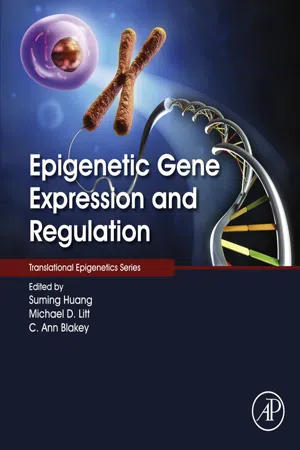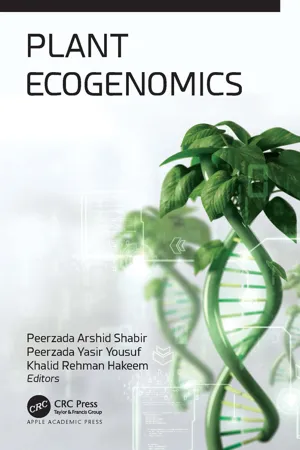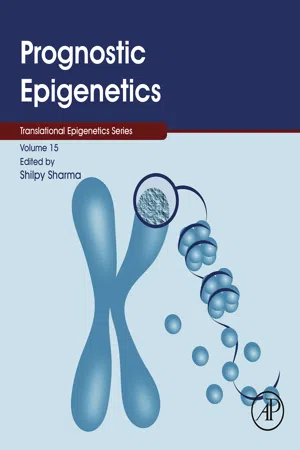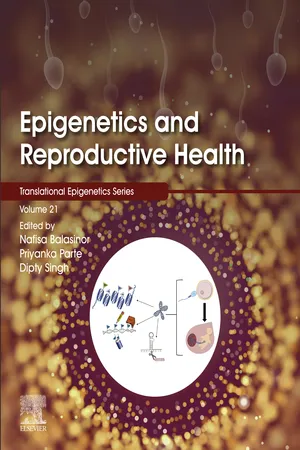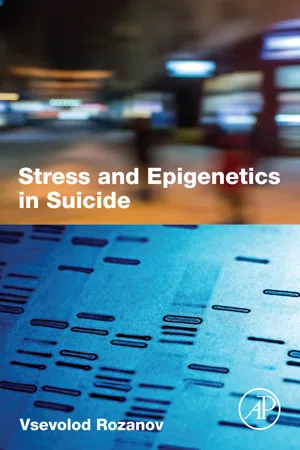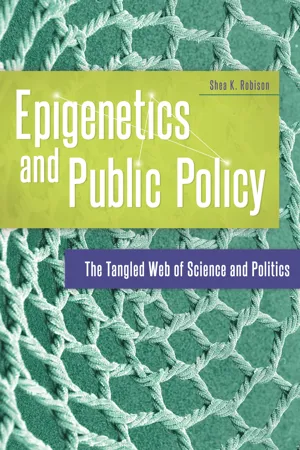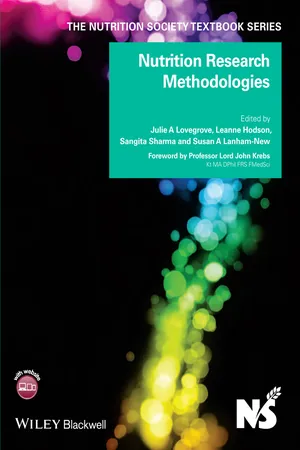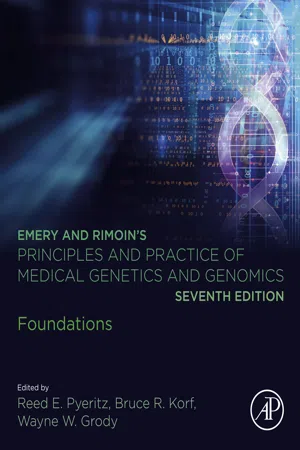Biological Sciences
Epigenetics
Epigenetics is the study of changes in gene expression that do not involve alterations to the DNA sequence. These changes can be influenced by environmental factors and can be passed down to future generations. Epigenetic mechanisms, such as DNA methylation and histone modification, play a crucial role in regulating gene activity and are important in development, disease, and evolution.
Written by Perlego with AI-assistance
Related key terms
Related key terms
1 of 4
Related key terms
1 of 3
10 Key excerpts on "Epigenetics"
- eBook - ePub
- Suming Huang, Michael D. Litt, C. Ann Blakey(Authors)
- 2015(Publication Date)
- Academic Press(Publisher)
1. Introduction
1.1. Epigenetics – a unifying concept for genetic mechanisms
One could argue that every aspect of a person’s health is influenced by the expression of their genes. There are approximately 20,000 protein-coding genes, though a seemingly ever-changing number, controlling the fate and development of cells within the human organism. This cacophony of differential gene expression influences an organism from the point of initial development upon fertilization, onward through each stage of growth and maturation, and includes all interactions—both genetic and environmental—at each of these stages. Consequently, understanding the mechanisms that control and regulate gene expression is pivotal to expanding our knowledge and tools to manipulate the health of the human organism. As a result, interpretation of genetic and environmental data, and how best to analyze and utilize that data, has become a key focus area in biomedical research. The implications for the development and application of treatments in clinical medicine are still in their infancy. However, current studies targeting diseases, nutritional-based issues, and environmental-associated damage have made remarkable advances through the use of the tools of genomics and bioinformatics, revealing a convergence into the field known as Epigenetics.At the birth of genetics, the underlying mechanisms of these processes may have eluded us; nonetheless, observational data analysis has led to significant discoveries tying the various fields of biological science together. In his 2014 review, A Brief History of Epigenetics, Felsenfeld [1] provides an excellent synthesis and perspective of Epigenetics, from both a historical and theoretical view of genetics. Epigenetics was originally used to describe the processes involved in the development of a zygote to a mature organism. Through a clear retrospective description of our stepwise progression from brilliant insights and clouded uncertainties to our current level of understanding, Felsenfeld [1] weaves together the rich tapestry that is our current understanding of Epigenetics. The depth of Epigenetics’ role becomes visible through the examination of the landmark discoveries and significant contributions of researchers across a range of organisms and questions. Past research discoveries allowed for an examination of connections and interactions from the gene to cellular to organismal levels. Molecular and genomic studies now allow for further refinement and redefining on all levels. A new perspective is therefore needed in order to consider the active role of genes, genomes, and gene/genome expression and interactions in the health of the organism and its future offspring. Thus, we now find ourselves looking upon a new epigenetic horizon with a far more complex landscape, encompassing and reaching beyond that originally envisioned by Waddington [2 –6] - eBook - ePub
- Peerzada Arshid Shabir, Peerzada Yasir Yousuf, Khalid Rehman Hakeem, Peerzada Arshid Shabir, Peerzada Yasir Yousuf, Khalid Rehman Hakeem(Authors)
- 2022(Publication Date)
- Apple Academic Press(Publisher)
Jablonka and Lamb, 2002 ).Recently, Epigenetics has been defined as the “study of heritable changes in the expression of gene and function that are unexplainable by differences in the sequence of DNA” (Richards 2006 ; Bird 2007 ). Such epigenetic modifications can turn on, bring down, or inhibit the function of particular genes:- Cytosine methylation of DNA
- Alteration of DNA packing via; chemical modification (addition of methyl or acetyl group) of histone proteins and
- Mediation of regulatory processes by sRNA (small RNA) molecules.
These processes are dependent on each other and control gene function in an interactive, complex fashion (Berger, 2007 ).Among the different epigenetic mechanisms which alter gene expression, in ecological Epigenetics most-common mechanism studied is methylation of cytosines in DNA (incorporation of a methyl group to CpG islands) (Schrey et al., 2013 ). Methylation of these sites often results in decreased activity of the associated gene and some methyltransferase enzymes catalyze this process. There are enough pieces of evidence that epigenetic changes can transfer to future generations as in toadflax, Arabidopsis thaliana, and mice (Richards 2006 ; Blewitt et al., 2006 ; Vaughn et al., 2007 ; Bock 2012 ). Methyltransferase enzyme affects the transgenerational inheritance of DNA methylation in plants, which replicates patterns of methylation during both meiosis and mitosis (Takeda and Paszkowski, 2006 ).A recent epigenetic study shows that natural variation in epigenetic modifications can be autonomous from DNA variation. For example, in Arabidopsis thaliana, large and consistent ecotypic variation in methylation of DNA has been found that was not associated with genetic variation (Cervera et al., 2002 ; Vaughn et al., 2007 ). Studies of polymorphism of DNA methylation by Keyte et al., (2006 - eBook - ePub
- (Author)
- 2019(Publication Date)
- Academic Press(Publisher)
Chapter 1Basics of Epigenetics: It is more than simple changes in sequence that govern gene expression
Shilpy Sharma; Osama Aazmi Department of Biotechnology, Savitribai Phule Pune University (Formerly University of Pune), Pune, IndiaAbstract
It is a widely accepted fact that distinction between species is defined not only by the ensemble of its genes but also more critically by how these genes are regulated such that the expression profiles change over space and time. Two major factors that determine gene expression and, in fact, a particular state of a functional cell, include genetics, the study of heritable changes in the nucleotide sequences, and Epigenetics, the study of mitotically and/or meiotically heritable alterations in gene expression that are not associated with changes in the underlying DNA sequences. Here, we provide an overview about the major epigenetic mechanisms including DNA methylation, histone posttranslational modifications, chromatin modifications, and noncoding RNAs (including miRNAs and lncRNAs) that govern changes in gene expression that are actually dependent on the environment and not on the underlying gene sequence. These mechanisms are potentially reversible and play crucial roles in regulating normal growth and differentiation. Alteration in the epigenetic marks have often been linked with different disease processes; and several attempts have been made to use these epigenetic modifications as a biomarker for the identification of individuals at risk and/or suffering from a disease condition using minimally invasive techniques. Additionally, the reversible nature of these epigenetic marks offers an attractive target for therapy, and hence, several drugs that target epigenetic factors and/or the linked pathways are currently being developed and/or tested in clinical trials. These topics have been extensively discussed through the length of this chapter. - eBook - ePub
- Trygve Tollefsbol(Author)
- 2020(Publication Date)
- Academic Press(Publisher)
The phenotypic changes that occur in the cells during the course of development in a multicellular organism were originally described as an “epigenetic landscape” by developmental biologist Conrad Waddingtion. Later, Holliday defined “Epigenetics” as nuclear inheritance which is not based on differences in DNA sequence. In its more modern version, Epigenetics is molecularly and mechanistically described as the sum of modifications to the chromatin template that come together to establish and propagate different patterns of gene expression and silencing from the same genome. If “genetics” can be considered as words, “Epigenetics” instructs how these words are read. Alternatively, if groups of genes can be thought of as computer hardware, epigenetic control can be compared with computer software. Thus, Epigenetics is an additional regulatory layer that provides insights into how cellular events are coordinated [ 5 ]. Epigenetic changes to the chromatin are brought about by three main mechanisms; namely, DNA methylation, post-translational histone modifications and non-coding RNAs. We attempt to provide a brief overview of these concepts in this chapter. DNA methylation Since its discovery more than 35 years ago [ 6 ], DNA methylation at the cytosine residues is recognized as one of the prime epigenetic mechanisms regulating gene expression. Cytosine residues are converted by the addition of a methyl group to 5-methylcytosine (5mC) in the DNA template. It mainly occurs in dinucleotide sequence 5′CpG3′ (i.e. CpG abbreviated for cytosine and guanine separated by phosphate group in the DNA). It can be transmitted by both the DNA strands, from mother to daughter cells during DNA replication and, can thus be inherited through cell division - eBook - ePub
- Vsevolod Rozanov(Author)
- 2017(Publication Date)
- Academic Press(Publisher)
Chapter 3What Is Epigenetics? Is It Transgenerational?
Abstract
Epigenetics comprises cases, when due to several molecular mechanisms that do not touch DNA sequences, in particular DNA methylation, histones modifications, and microRNAs effects, changes in transcriptional activity emerge that produce more or less stable and sometimes heritable phenotypes, including traits and behaviors. These events are triggered by environmental cues like chemical, physical, behavioral and social signals. The essence of Epigenetics is that transcriptional response is not only modulated by external influences but after being altered may remain stable for the whole future life of the organism. Within the individual development, early stages of life are mostly susceptible to environmental stressors, while functions, traits and behaviors established by epigenetic marks determine health and disease in future life, sometimes decades later. Generally speaking, early life influences are preparing organism for adaptation in a future environment, a phenomenon called ontogenetic programming. Moreover, such events may happen all through the life of the individual. Thus, the environment appears to be more important than genes, shifting our understanding of evolution, the origin of diseases, life-trajectory, aging, and longevity. Some epigenetically based phenotypes can be transmitted across generations in a context-dependent or germ-line dependent way or may fade with time if environmental factors change. This new biological and medical paradigm helps to understand changes in health and disease, including growing mental health problems of the human population within the context of social environments and growing level of psychosocial stress. - eBook - ePub
Epigenetics and Public Policy
The Tangled Web of Science and Politics
- Shea K. Robison(Author)
- 2018(Publication Date)
- Praeger(Publisher)
Again, a central assumption of the discussion of Epigenetics in this book is that the prevailing understanding of biology in a society is necessarily congruent with the prevailing politics and ethics. In the case of the recent emergence of Epigenetics, this necessary congruency also suggests that if the work being done in Epigenetics does in fact present a novel understanding of biology, this novel understanding of biology should in turn result in commensurate changes in the prevailing politics and ethics as well. As such, a primary goal of this book is to introduce the unique and largely unrecognized potential of Epigenetics for disrupting contemporary politics and policies.How Epigenetics WorksIn a nutshell, the science of Epigenetics is the study of the regulation and modification of gene expression through mechanisms other than changes in the underlying DNA, some of which may be passed on to subsequent generations. There are a number of biological mechanisms that have been identified as epigenetic in nature. Of these epigenetic mechanisms, DNA methylation, chromatin remodeling, and RNA-mediated inheritance are three of the most studied. For a better understanding of the new causal accounts introduced by Epigenetics, and therefore of what the emerging policy narratives of Epigenetics might look like and how these narratives of Epigenetics could challenge the existing narratives in different policy domains, a brief description of these different mechanisms follows.MethylationDNA methylation occurs when methyl (CH3 - eBook - ePub
- Julie A. Lovegrove, Leanne Hodson, Sangita Sharma, Susan A. Lanham-New, Julie A. Lovegrove, Leanne Hodson, Sangita Sharma, Susan A. Lanham-New(Authors)
- 2015(Publication Date)
- Wiley-Blackwell(Publisher)
14 Epigenetics John C MathersNewcastle UniversityKey messages
- Each individual has a fixed genotype, but his or her phenotype (e.g. adiposity and health status) is plastic in response to environmental factors, including nutrition, and this phenotypic plasticity can be mediated by epigenetic mechanisms.
- Epigenetics can be defined as the study of the processes through which gene expression (and cellular phenotype) is regulated, that are heritable across cell generations and that do not involve changes in the DNA sequence.
- Epigenetic mechanisms help regulate expression of the particular consortium of genes that is appropriate for a given cell type in the specific circumstances under study.
- The main epigenetic marks include methylation of cytosine residues within DNA and the covalent addition of chemical groups (e.g. phosphate, methyl and acetyl groups) to specific amino acid residues in the N-terminal tails of the histones around which DNA is wrapped in the cell nucleus.
- Epigenetically important molecules include the proteins that can ‘read’ the epigenetic marks on DNA and on histones and use this information to switch on, or switch off, the corresponding gene.
- MicroRNA are small RNA that do not code for proteins but regulate mRNA through base pairing with complementary sequences within the target mRNA species.
- Several dietary factors, including micronutrients and other plant food-derived bioactive compounds, result in changes in epigenetic marks and molecules, some of which lead to alterations in gene expression.
14.1 Introduction: The human genome and the regulation of gene expression
The human nuclear genome contains over 3 billion base pairs (bp) and the information to direct the synthesis of approximately 20 000 proteins. In addition, each mitochondrion within the cell contains about 16 600 bp, which encode just 37 genes. That said, any given human cell expresses only a small proportion of all the genes encoded in the genome. Most cells express a common set of genes, known as house-keeping genes, which are needed for generic purposes such as nutrient transport and adenosine triphosphate (ATP) generation. However, different cell types, such as neurones or hepatocytes, express consortia of genes that are characteristic of that cell type (described as cellular differentiation) and allow the cell to carry out the specific functions of the relevant cell type within particular tissues, for instance brain or liver. In addition, cells express distinctive complements of genes at different stages during development and in response to specific physiological states, for example epithelial cells in the breast during lactation. Cells also need to be able to respond appropriately to environmental factors such as dietary intake or exposure to chemical hazards. For all of these reasons, cells have evolved sophisticated, and dynamic, processes to ensure that the correct consortium of genes is expressed in a particular cell under the specific circumstances pertaining at that moment in time. - eBook - ePub
- Jules Janick, Jules Janick(Authors)
- 2014(Publication Date)
- Wiley-Blackwell(Publisher)
Developmental Plasticity and Evolution, the entire field of biology began to reconsider the relationship of development to genetics and evolution. Many of these very old ideas began to resurface, and now can be appreciated greatly in the modern context of Epigenetics.E. The Relationship of Genetics with Epigenetics: Resetting During Development
Many traits that appear to be epigenetic in both plants and animals are not only connected to growth but are also linked to responses to hormonal signals that can exert powerful control over growth. For instance, exposure of rat mothers and pups to a stressful environment where the mother offers less care in the form of licking/grooming arched back nursing (LG-ABN) causes an increased fear response in the pups that persists into adulthood and is reversible by environment changes, that is, epigenetic. The low LG-ABN trait has been traced to the effects of the stressful environment on the gene expression of the nerve growth factor inducible protein and its glucocorticoid receptor. This gene expression change, although not proven to result from an epi change, has been shown to be associated with promoter methylation status and the associated histone acetylation pattern (Youngson and Whitelaw 2008).The earlier and extensive work of Fred Meins and coworkers (Meins et al. 1980; Meins and Foster 1986) has also linked a hormonally controlled trait of plant cells and their growth to an apparent epigenetic status. Although the epigenetic marks associated with cytokinin habituation of plant cells have never been identified, Meins and coworkers have shown that this trait is not only transgenerational but, remarkably, its transgenerational inheritance also depends on the developmental state (Meins and Lutz 1979; Meins 1996). These experiments tie together five important concepts of Epigenetics: - eBook - ePub
Neurobiology of Social Behavior
Toward an Understanding of the Prosocial and Antisocial Brain
- Michael Numan(Author)
- 2014(Publication Date)
- Academic Press(Publisher)
Chapter 2Basic Genetics and Epigenetics
Abstract
Since genes control the synthesis of proteins, variations in the structure and function of neuron-related genes can influence the operation of the nervous system and social behavior. The gene is divided into a regulatory and a coding region, and the role of transcription factor action within the regulatory region in the control of gene expression is described. Genetic polymorphisms cause variations in the nucleotides within a gene, leading to different alleles of a gene, which could affect the amount of gene-related protein synthesized. Epigenetic processes influence whether a gene is in a euchromatin open and transcribable state, or a heterochromatin closed state. Histone acetylation and DNA methylation influence these processes. Postnatal experiences can affect whether neuron-related genes are euchromatin or heterochromatin. For example, maternal care influences the subsequent stress reactivity of offspring, with one mediating mechanism involving epigenetic effects on the transcribability of the glucocorticoid receptor gene.Keywords
DNA; Epigenetics; Gene–environment interaction; Gene transcription; Knockout mutation; mRNA; mRNA translation; Repetitive sequence polymorhism; Single nucleotide polymorphism; Stress reactivity2.1. Introduction
This chapter provides an introduction to the role of genes in neuron function and behavior. Genetic and environmental factors both influence behavior, including social behaviors, and these two factors often interact to mold the way in which brain and behavior develop. I will present the fundamentals of molecular biology, followed by concrete examples of how genes and environmental factors act together to affect developmental processes. These concepts will be important for a full understanding of the gene–social behavior relationships developed in future chapters. - eBook - ePub
- Reed E. Pyeritz, Bruce R. Korf, Wayne W. Grody(Authors)
- 2018(Publication Date)
- Academic Press(Publisher)
408 ]. These signatures have been found in various tissue types, including blood, brain, and buccal epithelium; the cross-tissue relevance of these signatures and their reflection in primary tissues of interest to each disorder are still being explored.5.11. The Future of Epigenomics
As we have highlighted throughout this chapter, the role of epigenetic marks in translating the primary genomic sequence has now moved to the forefront of human genetics, with clear implications for our understanding of human development and disease. While a good part of what we know about Epigenetics in disease came initially from cancer research, this topic has now been richly extended to nearly every common but genetically complex human disease. Large-scale epigenome projects have generated comprehensive maps of cell-type-specific epigenetic patterns, EWAS are beginning to reveal environmental effects on epigenomes, and fine mapping of allele-specific epigenetic marks is taking center stage as a post-GWAS approach for identifying functional genetic variants.In addition, epigenomics holds tremendous potential for identifying new molecular biomarkers of disease. Moreover, given their metastable and potentially transgenerational inheritance, epigenetic markers could function in a predictive capacity, allowing for the earlier detection of diseases and health outcomes. At the same time, NGS has revealed mutations in genes that code for epigenetic readers and writers associated not only with human cancers but also with a growing number of syndromic and nonsyndromic developmental disorders. These advances from basic research are starting to translate to drug discovery and will likely also provide useful molecular endpoints for monitoring individual therapeutic responses. For all these reasons, the field of Epigenetics will likely have a crucial role in the future of precision medicine.
Index pages curate the most relevant extracts from our library of academic textbooks. They’ve been created using an in-house natural language model (NLM), each adding context and meaning to key research topics.
Explore more topic indexes
Explore more topic indexes
1 of 6
Explore more topic indexes
1 of 4
